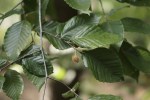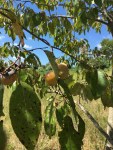The Tree Journal – Tulip Poplar (Liriodendron tulipifera)
Liriodendron tulipifera: that funky wood with the green streaks. You might know it as poplar, tulip poplar, or the fiddle tree. Poplar grows throughout the eastern United States, and reaches heights over 150 feet. In fact, it is the tallest eastern hardwood.
General Description
Poplar grows quickly and prefers deep-rich soils. However, it does not have many of the weakness issues seen in other fast growing species. The largest examples reach over 190-feet tall and 10-feet in diameter. Additionally, the trunk often climbs as high as 100 feet before the first branches appear.
The simple leaves alternate, and grow to 6-inches long and wide. To my eye, the leaves resemble the profile of the tulip flower, which makes them easy to spot. Like true poplar’s, Liriodendron tulipifera’s leaves flutter independently in the wind giving its canopy a bright appearance. In the spring, the tree produces independent flowers which resemble that of the tulip flower and, small brown cones form late fall.
Uses for Woodworkers
Despite being a hardwood, poplar is quite soft. As a result, it is easy to work with both hand tools and power tools. It produces a cream colored heartwood with streaks of grey and green. Sapwood is yellow or white and not always easily distinguished from heartwood. The grain is uniform and straight with diffuse porous end-grain.
Tulip poplar’s wide availability means that lumber is quite affordable. It is sustainable and doesn’t seem to produce severe allergic reactions. It makes an excellent choice for those starting with hand tools. It can produce nice furniture if you enjoy its non-traditional appearance. However, furniture makers generally use poplar as a utility hardwood. It is an excellent choice for hidden parts such as drawer sides.
Stay tuned for more!
Click here for the tree journal index.



















